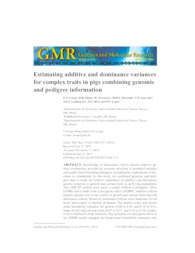Estimating additive and dominance variances for complex traits in pigs combining genomic and pedigree information.
Estimating additive and dominance variances for complex traits in pigs combining genomic and pedigree information.
Authorship: COSTA, E. V.; DINIZ, D. B.; VERONEZE, R.; RESENDE, M. D. V. de; AZEVEDO, C. F.; GUIMARÃES, S. E. F.; SILVA, F. F.; LOPES, P. S.
Summary: Knowledge of dominance effects should improve genetic evaluations, provide the accurate selection of purebred animals, and enable better breeding strategies, including the exploitation of heterosis in crossbreeds. In this study, we combined genomic and pedigree data to study the relative importance of additive and dominance genetic variation in growth and carcass traits in an F2 pig population. Two GBLUP models were used, a model without a polygenic effect (ADM) and a model with a polygenic effect (ADMP). Additive effects played a greater role in the control of growth and carcass traits than did dominance effects. However, dominance effects were important for all traits, particularly in backfat thickness. The narrow-sense and broad-sense heritability estimates for growth (0.06 to 0.42, and 0.10 to 0.51, respectively) and carcass traits (0.07 to 0.37, and 0.10 to 0.76, respectively) exhibited a wide variation. The inclusion of a polygenic effect in the ADMP model changed the broad-sense heritability estimates only for birth weight and weight at 21 days of age.
Publication year: 2015
Types of publication: Journal article
Unit: Embrapa Forestry
Observation
Some of Embrapa's publications are published as ePub files. To read them, use or download one of the following free software options to your computer or mobile device. Android: Google Play Books; IOS: iBooks; Windows and Linux: Calibre.
Access other publications
Access the Agricultural Research Database (BDPA) to consult Embrapa's full library collection and records.
Visit Embrapa Bookstore to purchase books and other publications sold by Embrapa.

